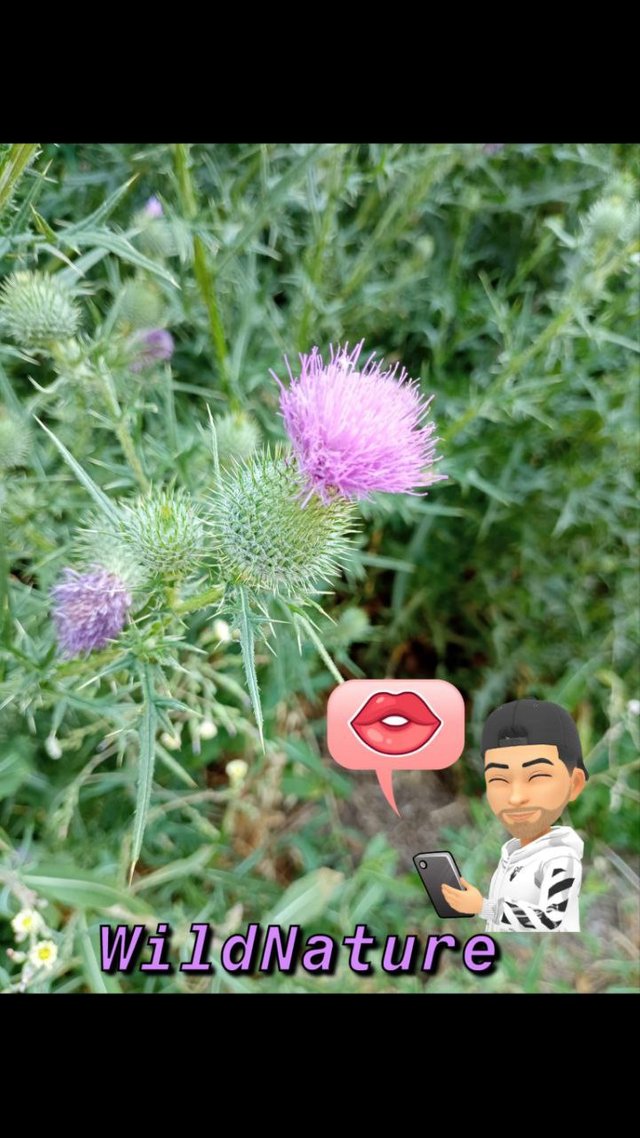Cardo asinino 🌿💜
The English version follows in the end.
Versione Italiana 🇮🇹🇮🇹🇮🇹

Il cardo asinino, conosciuto scientificamente come Onopordum acanthium, appartiene alla famiglia delle Asteraceae. Originario dell'Europa e dell'Asia occidentale, è diffuso in molte altre regioni del mondo dove cresce spontaneamente in terreni incolti, lungo i bordi delle strade e nei campi abbandonati.
Il cardo asinino è una pianta erbacea biennale, il suo fusto è robusto, eretto e ricoperto di una peluria biancastra. Le foglie sono grandi, lobate, con margini spinosi e una superficie rugosa di colore verde-grigiastro. Le foglie basali formano una rosetta durante il primo anno di crescita, mentre nel secondo anno la pianta sviluppa un fusto fiorale.
I fiori del cardo asinino sono capolini di grandi dimensioni, di colore violetto e circondati da brattee spinose. La fioritura avviene generalmente da giugno ad agosto. I capolini attirano numerosi insetti impollinatori, come api e farfalle, grazie al loro nettare abbondante.
Questa pianta predilige posizioni soleggiate e cresce bene in terreni ben drenati e poveri di nutrienti. È molto resistente alla siccità e può adattarsi a diverse condizioni ambientali, rendendola una specie robusta e poco esigente.
Il cardo asinino è conosciuto anche per le sue proprietà medicinali. Le sue parti aeree, in particolare le radici, sono utilizzate in fitoterapia per le loro proprietà diuretiche, digestive e tonificanti. Inoltre, le giovani foglie e i germogli possono essere consumati, previa cottura, in alcune ricette tradizionali.
E voi avete mai incontrato o coltivato il cardo asinino? Cosa ne pensate della sua fioritura e delle sue proprietà? Condividete le vostre esperienze nei commenti e lasciate un "like" se apprezzate questa pianta robusta e affascinante! 👍🌿💜
(Foto scattata da me) 📸
English version 🇬🇧🇬🇧🇬🇧

The cotton thistle, scientifically known as Onopordum acanthium, belongs to the Asteraceae family. Native to Europe and Western Asia, it is widespread in many other regions of the world where it grows wild in uncultivated land, along roadsides, and in abandoned fields.
The cotton thistle is a biennial herbaceous plant with a robust, erect stem covered in whitish hair. The leaves are large, lobed, with spiny edges and a rough surface of grayish-green color. The basal leaves form a rosette during the first year of growth, while in the second year, the plant develops a flowering stem.
The flowers of the cotton thistle are large, violet-colored capitula surrounded by spiny bracts. Blooming generally occurs from June to August. The capitula attract numerous pollinating insects, such as bees and butterflies, due to their abundant nectar.
This plant prefers sunny positions and thrives in well-drained, nutrient-poor soils. It is highly drought-resistant and can adapt to various environmental conditions, making it a hardy and undemanding species.
The cotton thistle is also known for its medicinal properties. Its aerial parts, particularly the roots, are used in phytotherapy for their diuretic, digestive, and tonic properties. Additionally, the young leaves and shoots can be consumed, after cooking, in some traditional recipes.
Have you ever encountered or cultivated the cotton thistle? What do you think of its blooming and properties? Share your experiences in the comments and leave a "like" if you appreciate this hardy and fascinating plant! 👍🌿💜
(Photo taken by me) 📸
Che post interessante! 🌿💜 Non sapevo che il cardo asinino avesse così tante proprietà medicinali e fosse così resistente. Le tue foto sono bellissime e mi hanno fatto apprezzare ancora di più questa pianta affascinante. Grazie per aver condiviso queste informazioni! 👍😊
Sono felice che tu abbia trovato interessante il post sul cardo asinino. È davvero una pianta sorprendente con molte proprietà medicinali e una grande resistenza. Grazie mille per il tuo gentile commento! 😊